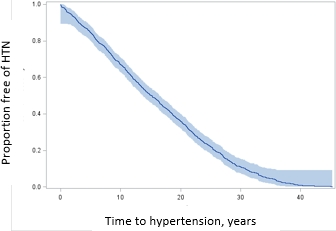Landscape of Hypertension Treatment in Former Kidney Donors.
U of MN, Mpls.
Meeting: 2016 American Transplant Congress
Abstract number: A141
Keywords: Donation, Hypertension, Kidney
Session Information
Session Name: Poster Session A: Kidney Donor Outcomes
Session Type: Poster Session
Date: Saturday, June 11, 2016
Session Time: 5:30pm-7:30pm
 Presentation Time: 5:30pm-7:30pm
Presentation Time: 5:30pm-7:30pm
Location: Halls C&D
The aim of this analysis is to describe the general epidemiological features for the development of hypertension and the most frequent medical therapies prescribed in a cohort of living kidney donors.
Of the 4267 living kidney donors spanning 1963-2014, 1121 (26.3%) developed post-donation hypertension. Figure 1 shows that at 7.2, 15.1 and 23.7 years post donation 25%, 50% and 75%, respectively develop hypertension.
Donors who developed hypertension were older at donation (40.4 (0.3) vs. 37.9 (0.2) years, p < 0.0001), have had longer followup time (28.9 (11) vs. 19.3 (12) years, p < 0.0001), smokers (36% vs 32%), had a higher BMI (26.2 (0.1) vs. 25.6 (0.1) kg/m2, p = 0.0004); and a lower eGFR (93.3 (0.5) vs. 95.9 (0.3) mL/min, p < 0.0001). In addition, they also had higher donation systolic (120.9 (0.4) vs. 118.6 (0.2) mmHg, p < 0.0001) and diastolic (75.3 (0.3) vs. 72.1 (0.2) mmHg, p < 0.0001) blood pressures, greater blood glucose (95.5 (0.5) vs 92.8 (0.3) mg/dL, p < 0.0001) and greater blood triglycerides (136.0 (4.4) vs. 119.6 (2.4) mg/dL, p = 0.001). Family history of hypertension was not different between hypertensive and non-hypertensive donors.
Angiotensin converting enzyme (ACE) inhibitor or an angiotensin receptor blocker (ARB) were used as the only medication in 28% and 11% of hypertensive donors, respectively. In 24% of hypertensive donors a diuretic was used as the only medication followed by calcium channel blockers (15.1%) and vasodilators (16.1%). In 31% of cases ACE inhibitors or ARB are combined with a diuretic, a calcium channel blocker or a vasodilator.
Donors who developed hypertension, at last follow-up, are also more likely to have significant proteinuria (14.5% vs. 2.8%), have lower eGFR (65.2 (0.6) vs. 65.5 (0.3), p = 0.0001), are at higher relative risk of ESRD (2.20, 95% CI: 0.99, 4.91, p = 0.05) and cardiovascular disease (4.3, 95% CI: 3.6, 5.2), but not death (p = 0.3) after adjusting for demographic factors.
Conclusion: Risk factors for the development of hypertension are similar to those observed in non-donor population. Assuringly, ACE-inhibition and ARB are the most commonly used anti-hypertensives but this proportion, one would argue, should be 100%.

CITATION INFORMATION: Ferrara L, Sanchez O, Berglund D, Matas A, Ibrahim H. Landscape of Hypertension Treatment in Former Kidney Donors. Am J Transplant. 2016;16 (suppl 3).
To cite this abstract in AMA style:
Ferrara L, Sanchez O, Berglund D, Matas A, Ibrahim H. Landscape of Hypertension Treatment in Former Kidney Donors. [abstract]. Am J Transplant. 2016; 16 (suppl 3). https://atcmeetingabstracts.com/abstract/landscape-of-hypertension-treatment-in-former-kidney-donors/. Accessed December 12, 2025.« Back to 2016 American Transplant Congress
